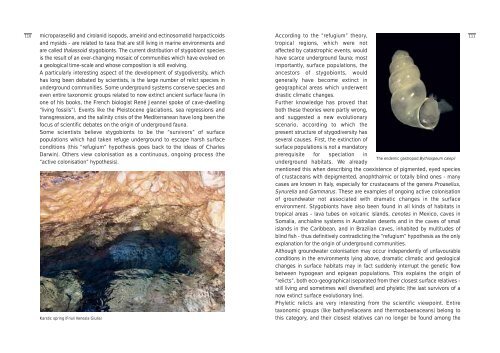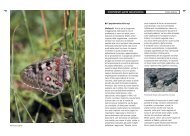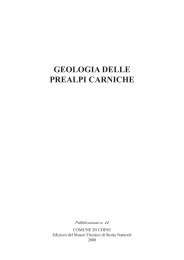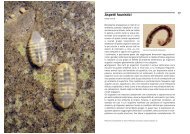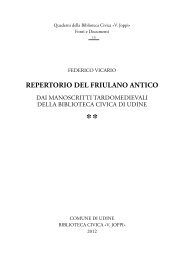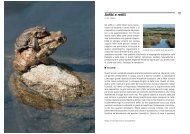Despite its inhospitable appearance and lack of any ... - Udine Cultura
Despite its inhospitable appearance and lack of any ... - Udine Cultura
Despite its inhospitable appearance and lack of any ... - Udine Cultura
Create successful ePaper yourself
Turn your PDF publications into a flip-book with our unique Google optimized e-Paper software.
110<br />
microparasellid <strong>and</strong> cirolanid isopods, ameirid <strong>and</strong> ectinosomatid harpacticoids<br />
<strong>and</strong> mysids - are related to taxa that are still living in marine environments <strong>and</strong><br />
are called thalassoid stygobionts. The current distribution <strong>of</strong> stygobiont species<br />
is the result <strong>of</strong> an ever-changing mosaic <strong>of</strong> communities which have evolved on<br />
a geological time-scale <strong>and</strong> whose composition is still evolving.<br />
A particularly interesting aspect <strong>of</strong> the development <strong>of</strong> stygodiversity, which<br />
has long been debated by scientists, is the large number <strong>of</strong> relict species in<br />
underground communities. Some underground systems conserve species <strong>and</strong><br />
even entire taxonomic groups related to now extinct ancient surface fauna (in<br />
one <strong>of</strong> his books, the French biologist René Jeannel spoke <strong>of</strong> cave-dwelling<br />
“living fossils”). Events like the Pleistocene glaciations, sea regressions <strong>and</strong><br />
transgressions, <strong>and</strong> the salinity crisis <strong>of</strong> the Mediterranean have long been the<br />
focus <strong>of</strong> scientific debates on the origin <strong>of</strong> underground fauna.<br />
Some scientists believe stygobionts to be the “survivors” <strong>of</strong> surface<br />
populations which had taken refuge underground to escape harsh surface<br />
conditions (this “refugium” hypothesis goes back to the ideas <strong>of</strong> Charles<br />
Darwin). Others view colonisation as a continuous, ongoing process (the<br />
“active colonisation” hypothesis).<br />
Karstic spring (Friuli Venezia Giulia)<br />
According to the “refugium” theory,<br />
tropical regions, which were not<br />
affected by catastrophic events, would<br />
have scarce underground fauna; most<br />
importantly, surface populations, the<br />
ancestors <strong>of</strong> stygobionts, would<br />
generally have become extinct in<br />
geographical areas which underwent<br />
drastic climatic changes.<br />
Further knowledge has proved that<br />
both these theories were partly wrong,<br />
<strong>and</strong> suggested a new evolutionary<br />
scenario, according to which the<br />
present structure <strong>of</strong> stygodiversity has<br />
several causes. First, the extinction <strong>of</strong><br />
surface populations is not a m<strong>and</strong>atory<br />
prerequisite for speciation in<br />
The endemic gastropod Bythiospeum calepii<br />
underground habitats. We already<br />
mentioned this when describing the coexistence <strong>of</strong> pigmented, eyed species<br />
<strong>of</strong> crustaceans with depigmented, anophthalmic or totally blind ones - m<strong>any</strong><br />
cases are known in Italy, especially for crustaceans <strong>of</strong> the genera Proasellus,<br />
Synurella <strong>and</strong> Gammarus. These are examples <strong>of</strong> ongoing active colonisation<br />
<strong>of</strong> groundwater not associated with dramatic changes in the surface<br />
environment. Stygobionts have also been found in all kinds <strong>of</strong> habitats in<br />
tropical areas - lava tubes on volcanic isl<strong>and</strong>s, cenotes in Mexico, caves in<br />
Somalia, anchialine systems in Australian deserts <strong>and</strong> in the caves <strong>of</strong> small<br />
isl<strong>and</strong>s in the Caribbean, <strong>and</strong> in Brazilian caves, inhabited by multitudes <strong>of</strong><br />
blind fish - thus definitively contradicting the “refugium” hypothesis as the only<br />
explanation for the origin <strong>of</strong> underground communities.<br />
Although groundwater colonisation may occur independently <strong>of</strong> unfavourable<br />
conditions in the environments lying above, dramatic climatic <strong>and</strong> geological<br />
changes in surface habitats may in fact suddenly interrupt the genetic flow<br />
between hypogean <strong>and</strong> epigean populations. This explains the origin <strong>of</strong><br />
“relicts”, both eco-geographical (separated from their closest surface relatives -<br />
still living <strong>and</strong> sometimes well diversified) <strong>and</strong> phyletic (the last survivors <strong>of</strong> a<br />
now extinct surface evolutionary line).<br />
Phyletic relicts are very interesting from the scientific viewpoint. Entire<br />
taxonomic groups (like bathynellaceans <strong>and</strong> thermosbaenaceans) belong to<br />
this category, <strong>and</strong> their closest relatives can no longer be found among the<br />
111


